SAN ANGELO, TX — San Angelo is home to one of the oldest homeless encampments in Texas, located on 14th street in a heavily wooded area sitting on 3 acres of private property. Homelessness has more than doubled in San Angelo from 2022 to the present day, according to the "Point-In-Time" Count. The PIT count is conducted by the United States Census, and was created with the mission of attaining "an accurate and complete count which is imperative for communities to move towards more extensive resources." The most recent U.S. Census PIT count was conducted on January 25th, 2024.
The Problem of Homelessness in San Angelo
The explosion in the number of people experiencing homelessness is often blamed on the rapid rate of inflation and unemployment, which is at an all-time high and the preposterously low working wages people receive for entry-level jobs inevitably leads to a crippling economic phenomenon called “stagflation.” Is stagflation the root of the homelessness problem though? Homelessness in San Angelo has dramatically increased over the past three years. From 2022 to 2023 homelessness in San Angelo alone doubled.
Since homelessness is a complex problem relevant to our city, San Angelo LIVE will be publishing and producing a series of articles, interviews, photos, videos, and additional content on homelessness in San Angelo. San Angelo LIVE reporters will investigate the city’s homelessness problem to discover additional contributing factors such as increased drug abuse/addiction, mental illness, an increase in population due to people moving to Texas from states like California and Arizona, and “one-off” exceptions such as those who have lost their jobs, are in between jobs, or have fallen on hard economic times for other personal reasons.
This article will be the first of several in the San Angelo LIVE series on homelessness. During their initial visit to the camp Sunday, the two reporters entered the camp without cameras, microphones, or cell phones and brought hygiene care packages to hand out to residents in need of products like deodorant, toothbrushes, toothpaste, soap, etc. The goal was to establish rapport, gain trust with residents, and investigate their living conditions, and the inner workings of the homeless camp. After gaining the trust of a few residents, the reporters were given limited permission to take a few photos and videos of “pop=up” living quarters and to get an overall layout of the camp. Additionally, the reporters were granted permission to, film an interview with one of the camp’s “permanent residents,” along with an off-camera (on-record) interview with the alleged property owner.
On-Record Interview with Property Owner
The homeless camp has nearly doubled in size according to the property owner, who we will call John S. to respect privacy. John said that he purchased the property about five years ago and since purchasing it, he has seen a major influx of people in the camp and and has had a much harder time keeping the property clean and organized. John said his role “these days,” is to manage the property from afar and work to “cut down the nonsense” that takes place in the camp. John explained that he decided to hand over most of the acting authority of the camp to three local churches.
When asked about what his ultimate goal was with the property and what he was trying to accomplish, John answered “Personal experience.” He voiced that he was once a resident at the encampment before purchasing the property. John said he was living at the camp during the Texas ice storm in February 2021. He recounted the experience, “Yeah I was living here during the ice/snow storm when everything got shut down. We just had to make do. We helped each other out and came together and just hunkered down and pushed through it together. It was a tough deal but we made it.”
He said that he understands what people go through experiencing homelessness and felt led to make it his mission to provide a place for anyone who’s fallen on hard times. John expressed that this was his primary aim. He wanted to provide a place for people in this situation to call their own without being forced out by police or city officials. He expanded on this, “We are all family here at the camp. This is my family. We help each other out and look after one another like a real community should.”
The reporters asked John about his dealings with both The City of San Angelo and the San Angelo Police Department.
John stated “Yeah they come around here fairly often, seems like a lot more often lately. They are always getting onto us about the uncleanliness and all the trash everywhere. They're constantly pushing us to keep the area clean and to avoid making big piles of debris or clothing or both.”. As far as the Police Department is concerned, John told us that they come around the camp sometimes when someone has gone missing or run-away. John told us facetiously “I guess they think we are hiding them here somewhere.”
"Working together to more effectively help people experiencing homelessness become self-sufficient in San Angelo."
— Terry Shaner - Past-Executive Director of Concho Valley Homeless Planning Coalition
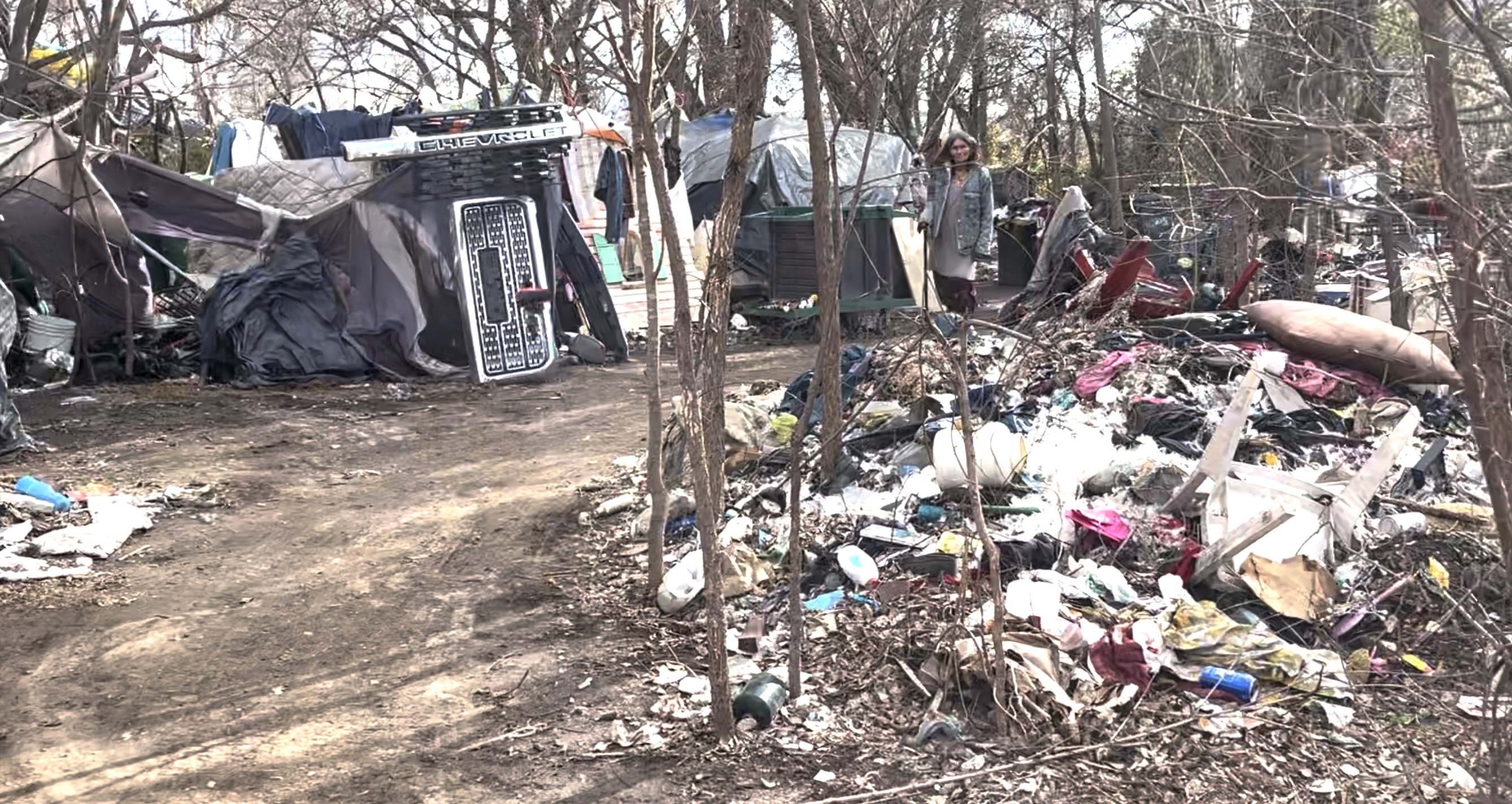
Walking into Camp
(Credit: SA LIVE Matt Cutrer)
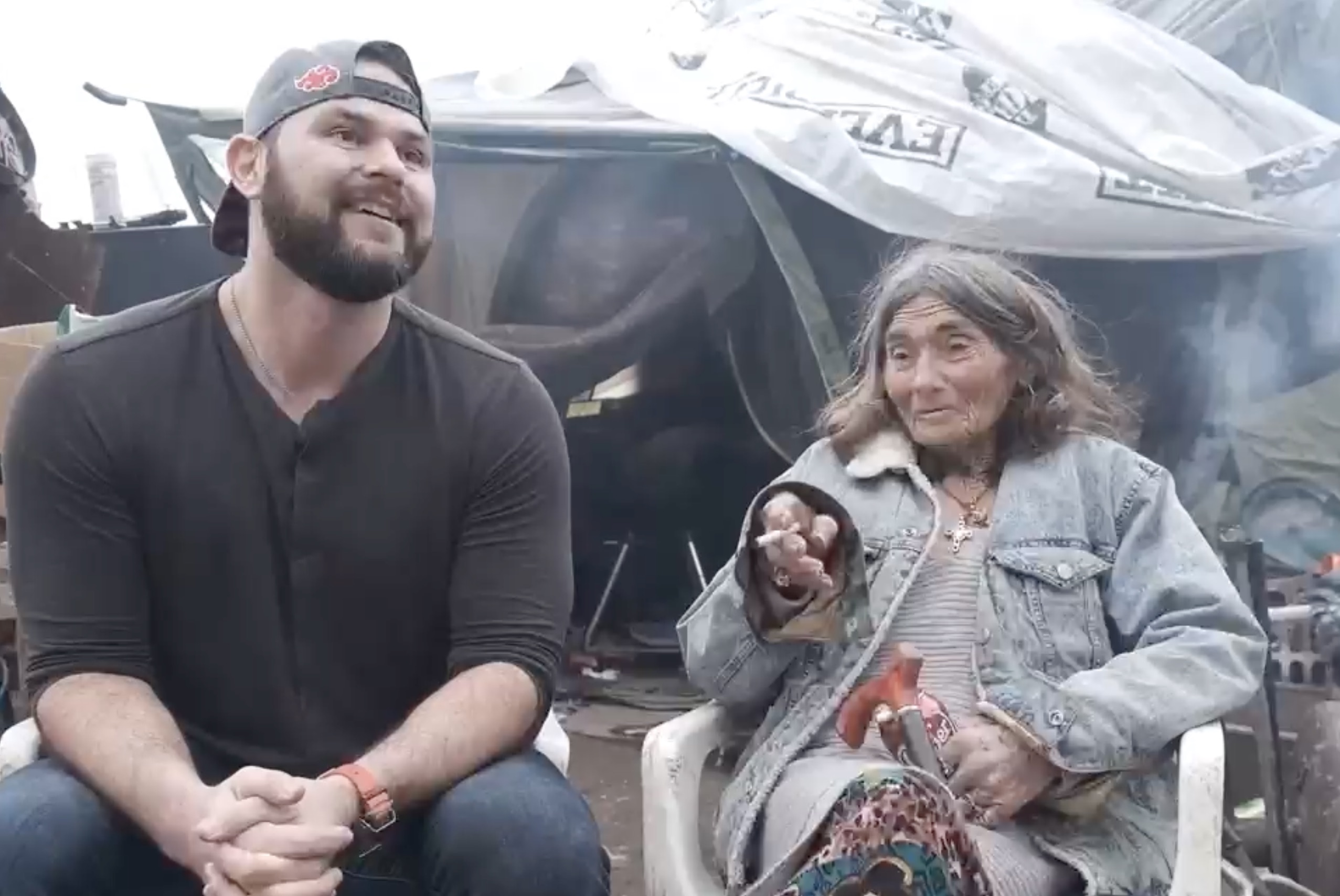
Interview with Mary-Lou
(Credit: SA LIVE, Lucas Banda)
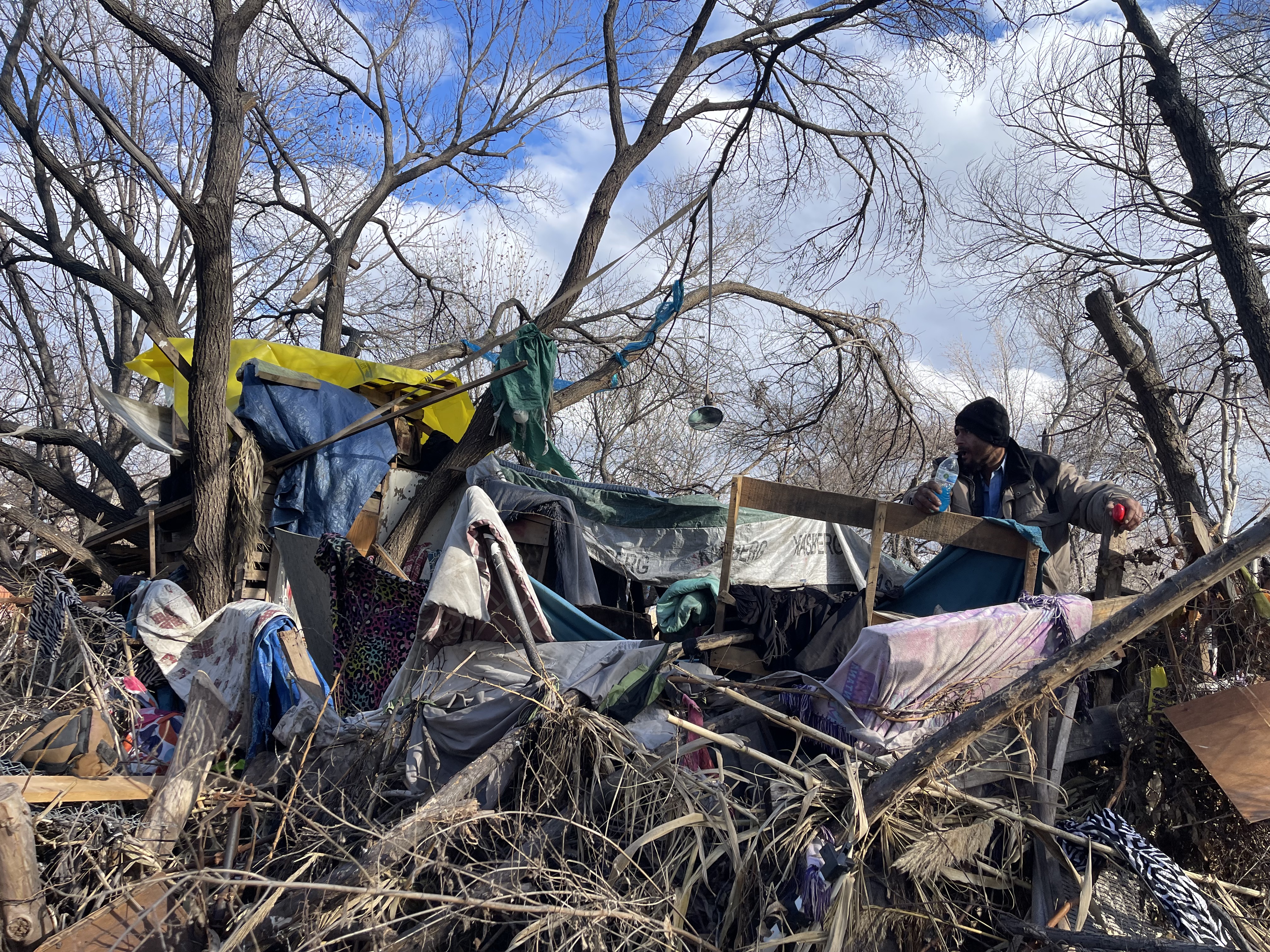
Tree House in the Homeless Camp on 16th
(Credit: SA Live, Matt Cutrer)
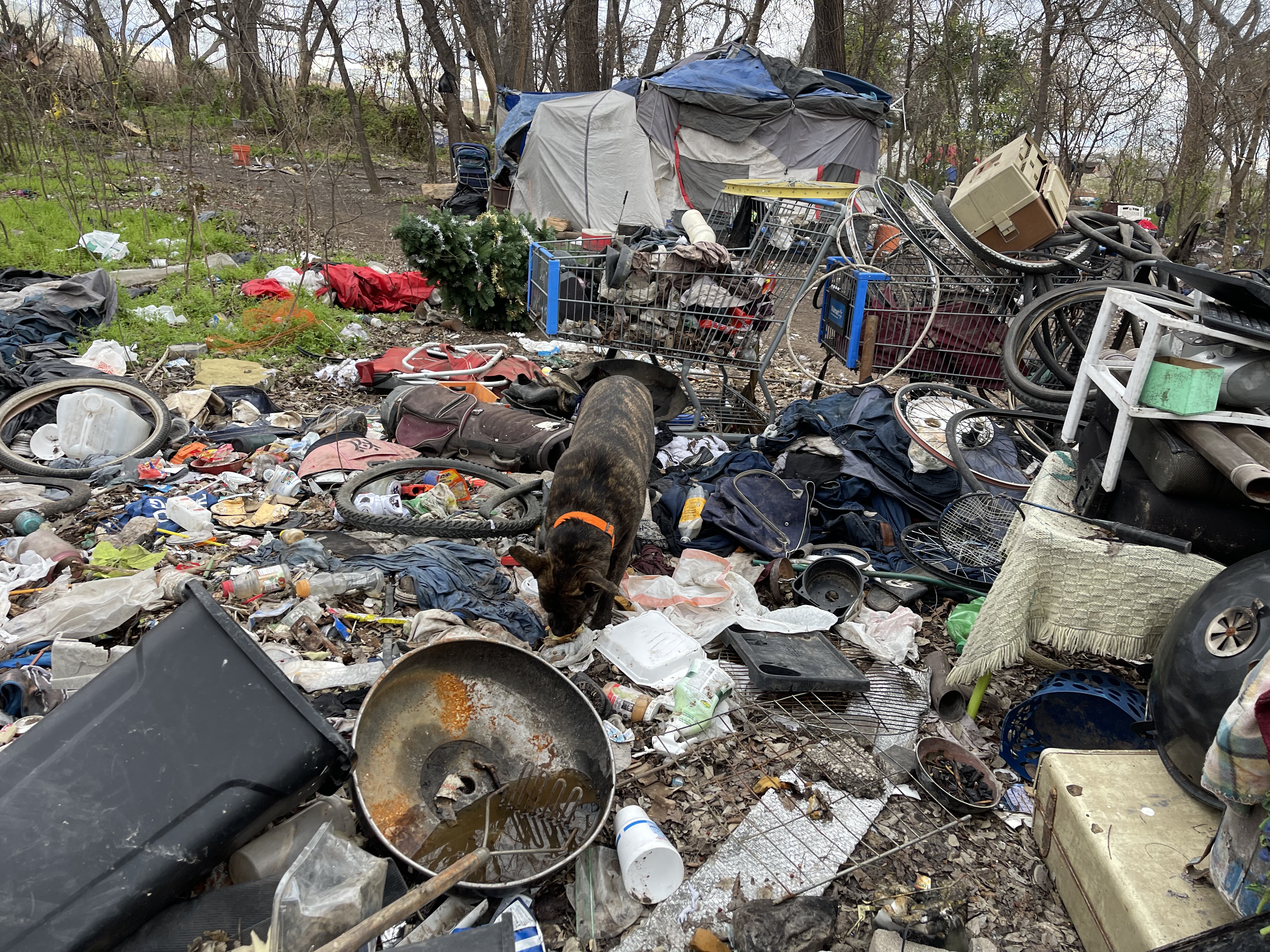
Stray Dogs Throughout the Camp
(Credit: SA Live, Matt Cutrer)
Filmed Interview with Camp Resident Mary-Lou
The two LIVE reporters also interviewed an elderly woman who is a semi-permanent resident of the camp.. 73-year-old Mary-Lou was born and raised in San Angelo and born at Shannon Hospital in the early 1950s. She lived off of Bell Street on Coke Street and attended Lake View High School. Mary-Lou stated that she dropped out of school and immediately began raising a family instead of attending college.
Mary-Lou has been experiencing homelessness for quite some time, telling reporters she has lived at the camp on three separate occasions. Her pop-up home quarters consist of used plywood, random recycled lumbar, boxes, clothing, and tarps of various types. Her living quarters are shaped in the form of a circle and the center of the home is a fairly open space with a dirt floor. From what could be assumed, the quarters were separated into individual rooms or compartments, divided with either tarp or sheets. Each room was tarped off from view for privacy. Directly behind her was her bedroom with a used mattress on the ground and other various items used for everyday living.
Mary-Lou also had an old barbecue pit that stood about two feet off the ground that she used to start fires for warmth and cooking. While there, just before beginning the filmed interview a young couple in their mid-twenties stood next to Mary-Lou in her quarters, building a fire in the pit to help her stay warm.. When asked about their endeavor, the two residents replied, “We are helping her to keep warm tonight by building this fire. We always try to help each other out like this.”
When asked about their behavior and whether or not it was typical in the camp, Mary-Lou responded, “Yeah, at the end of the day we are all in this together. This is our little community and we are family. Sure we fight over food sometimes and have little squabbles but at the end of the day we are always there for each other.”
Mary-Lou also informed reporters that the camp was one of the oldest Homeless encampments in Texas. She also explained that “the camp has a fairly organized community that is self-governed with enforced rules, procedures, and expectations." Surprisingly, Mary-Lou explained that the camp has a designated resident who has the authority to make major decisions, enforce rules and procedures, manage conflict, and ensure everyone is “well taken care of.” Mary-Lou spoke about this leader fondly and told LIVE reporters that he was very helpful and well-liked within the camp. She also explained that although the camp is open to the public, becoming a resident is a different story. According to Mary-Lou, for a newcomer to become a resident at the camp, current residents must participate in a democratic voting procedure. All residents must unanimously vote in favor of the candidate to become a resident before they are permitted to stay long-term.
The reporters asked Mary-Lou to provide an example of the kind of rules agreed upon and enforced at the camp. Without hesitation, Mary-Lou said that “No Stealing” was one of the biggest and most important rules within the camp community. She explained that stealing another resident's food or property is the biggest violation one can make and that the camp’s enforcers have a zero-tolerance policy for such behavior. Those caught stealing are immediately kicked out of the camp and banned. Also, it can be assumed that those caught stealing receive a physical punishment as well. Mary-Lou eluded to the existence of additional rules but declined to disclose further information on the matter.
Identifying Factors Contributing to the Homelessness Problem in San Angelo
Many blue-collar job opportunities simply do not exist anymore like they once did in rural communities. During the 1970s through the 1990s, most Texas cities typically had at least one major factory or power plant responsible for employing hundreds of blue-collar workers limited to specific skill sets. With the rapid advancement of technology and evolving economy, Texas cities are less reliant on major resources like coal, oil, steel, and farming & agriculture and therefore employ far fewer people for factory and plant jobs. This left them without wages and displaced within their communities. As a result, these displaced individuals with blue-collar level skills were alienated and often fell through the cracks, ending up in homeless camps, institutions, jails, or minimum-wage jobs while living with relatives.
The San Angelo LIVE reporters concluded after the first visit to the 14th Street homeless camp that many factors exacerbate the homelessness problem in San Angelo. One of the biggest takeaways from this initial visit is that many of these people have been impacted by economic hardship, assumably as a residual circumstance spawned by the COVID-19 pandemic. Also, other residents of the camp seemed to be “one-off” individuals experiencing homelessness who use the camp as a temporary “go-between” when they require a place to stay temporarily. Many of them have lost their jobs, were kicked out of their current living situation, are awaiting government assistance, or have mental illnesses such as PTSD. The reporters overhead residents discussing living expenses and the cost of apartment rentals in town and others who were waiting on government assistance checks to arrive. A few residents also told the reporters that they “aren't from San Angelo,” and that they “are just passing through.” Additionally, some residents insisted that we not take photos of them or record anything they say. These individuals clearly stated that their identities remain anonymous and they refused further involvement in any way. Therefore, it's reasonable to assume that the camp also acts as an asylum for criminals, bail jumpers, and those wanted for outstanding warrants. Lastly, the reporters encountered two residents with mental illnesses such as military veterans with PTSD.
Conclusion
In Conclusion, the 14th Street Homeless camp is a piece of private property owned by an ex-homeless man with a vision and a place that exists “off-the-grid,” for those with mental illnesses, who are experiencing economic hardship, who are currently without homes, or those who are seeking asylum. A big part of The Concho Valley Homeless Planning Coalition's mission is "To make the communities of the Concho Valley more responsive to the needs and interests of the homeless population by mobilizing all available resources to bring about a greater institutional sensitivity to the needs of the homeless and help meet those needs." San Angelo LIVE will continue to investigate the problem and publish updates and proposed solutions as fast as possible. Both San Angelo LIVE reporters Matt Cutrer and Lucas Banda will be investigating this issue further. The next article will be published by Lucas Banda as the two reporters dive deeper into homelessness during interviews with city officials, police, and the director of the Concho Valley Homeless Planning Coalition.
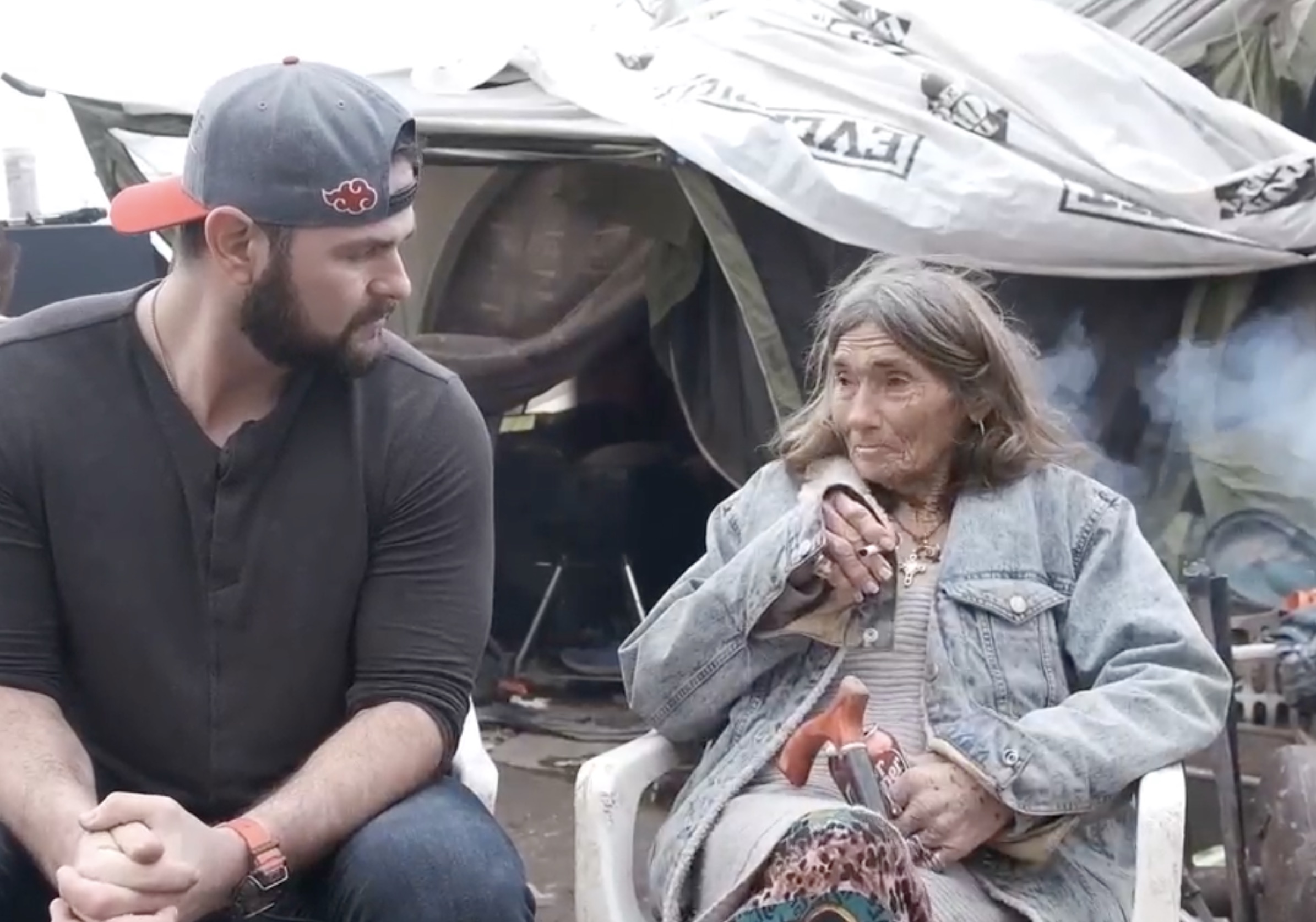
Confronting the Problem of Homlessness
(Credit: SA LIVE, Lucas Banda)
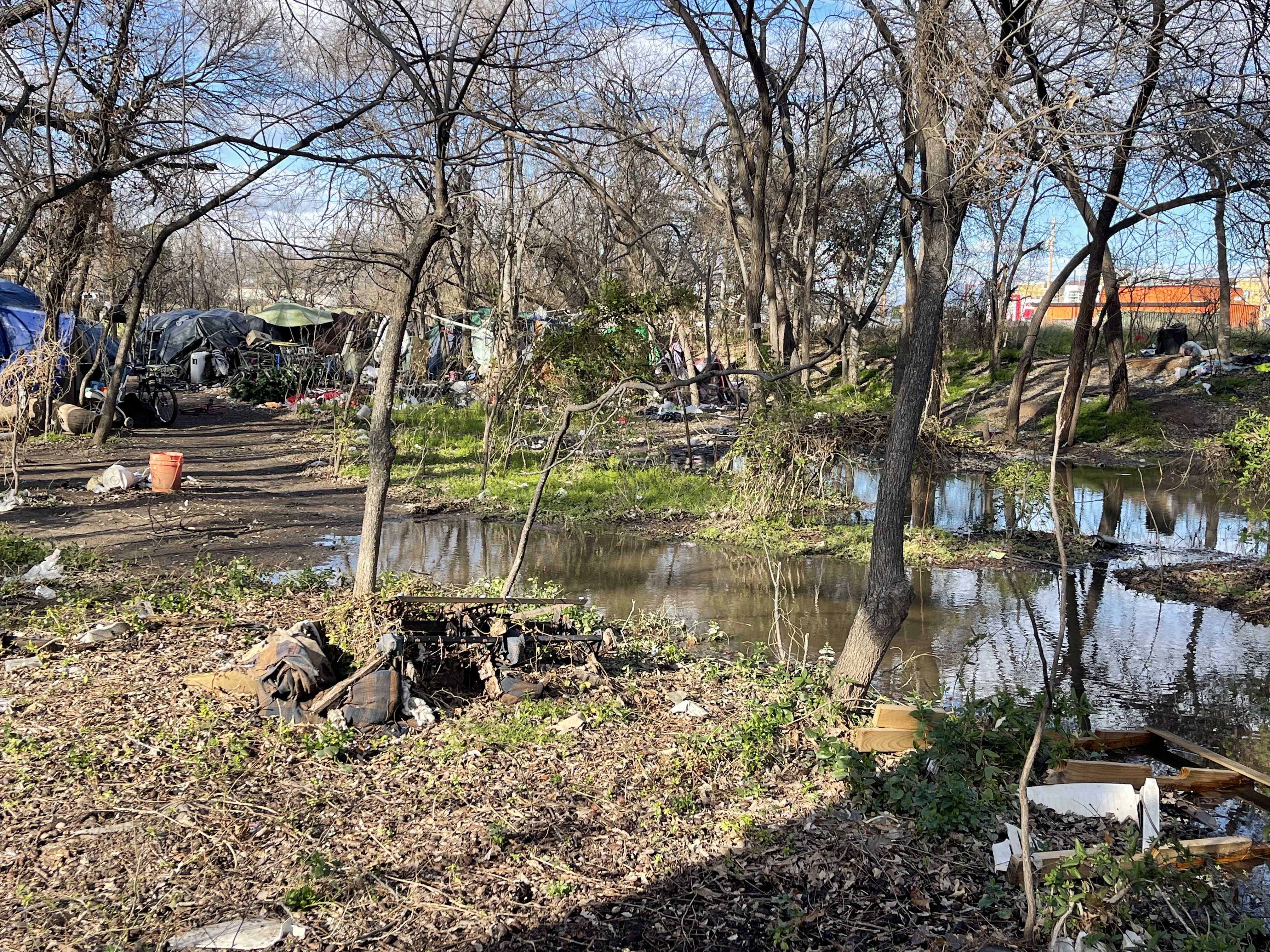
Flooding in the Camp
(Credit: SA LIVE, Matt Cutrer)
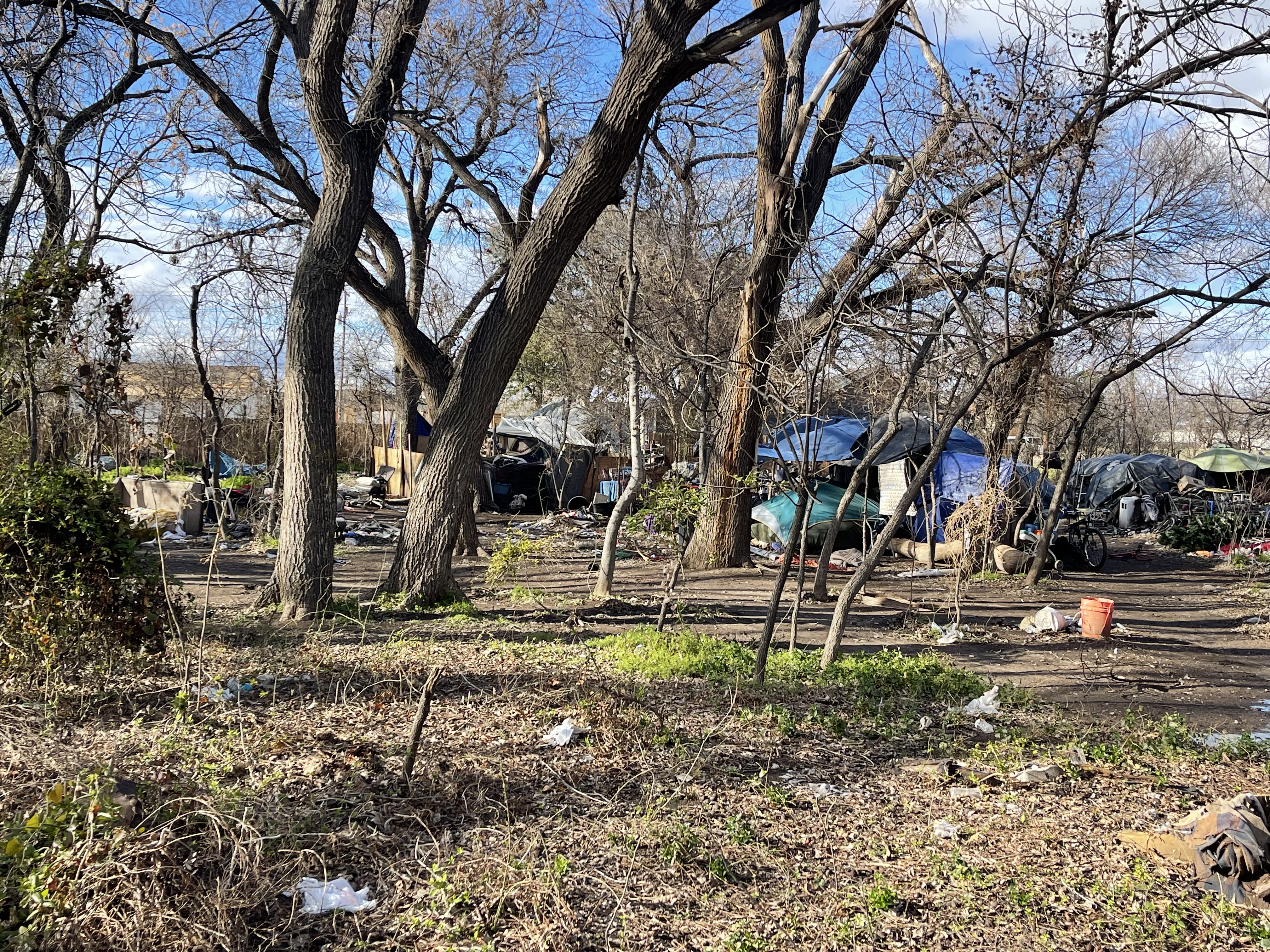
Huge Trees Throughout the Camp
(Credit: SA LIVE, Matt Cutrer)
Subscribe to the LIVE! Daily
Required



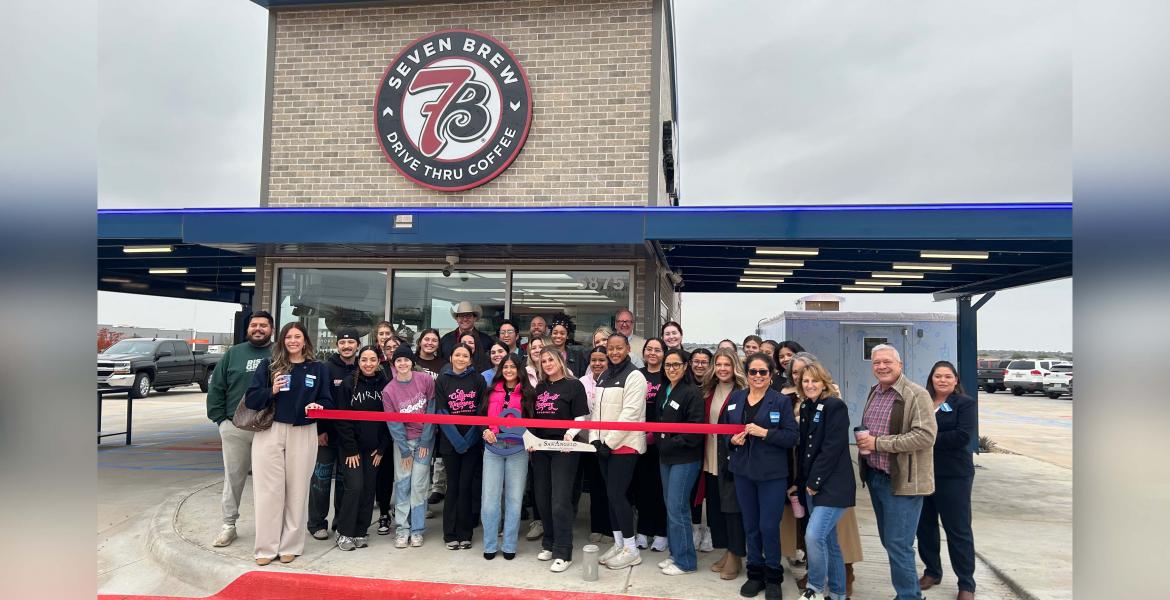
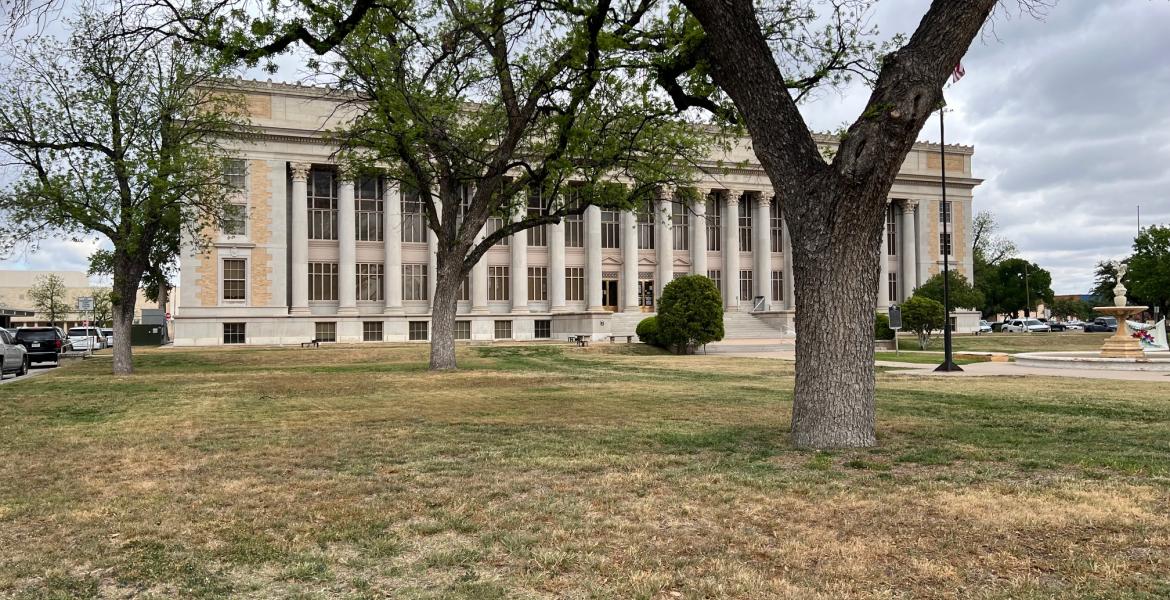

Comments
Listed By: sanglo expat
Go a lot of us.
- Log in or register to post comments
PermalinkStrange that we send BILLIONS in aid to countries that laugh about us, but refuse to take care of our own.
- Log in or register to post comments
PermalinkPost a comment to this article here: